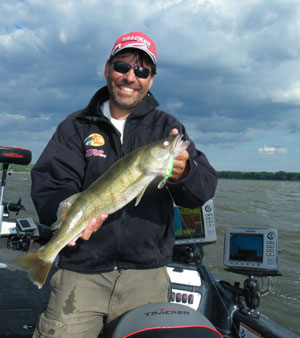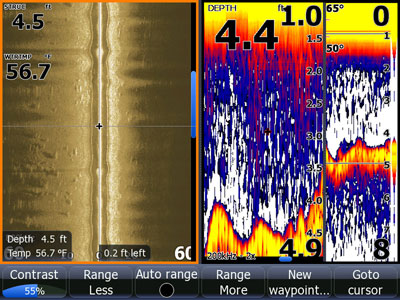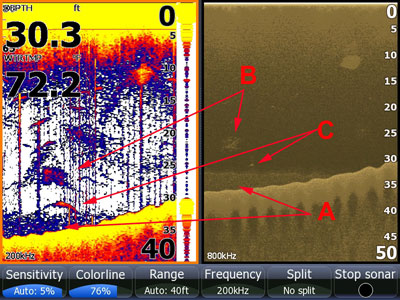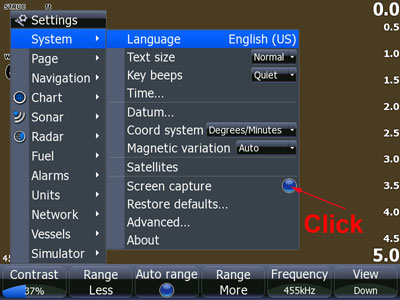 Now that the “open water” walleye fishing season is winding down for most of us, it’s a good time to reflect on things we learned these past months and begin making plans to improve our angling success for next year. For some that will mean researching new waters, for others it may be some “tweaking” in the equipment arsenal and for some it may simply be a matter of getting in more time on the water. If we were going to pinpoint one thing every walleye angler could do to improve their fish catching success it would be to concentrate on more efficiently finding fish. To state the obvious; you can’t catch ‘em if you can’t find ‘em. This is definitely one area of angling where technology can make a huge difference.
Now that the “open water” walleye fishing season is winding down for most of us, it’s a good time to reflect on things we learned these past months and begin making plans to improve our angling success for next year. For some that will mean researching new waters, for others it may be some “tweaking” in the equipment arsenal and for some it may simply be a matter of getting in more time on the water. If we were going to pinpoint one thing every walleye angler could do to improve their fish catching success it would be to concentrate on more efficiently finding fish. To state the obvious; you can’t catch ‘em if you can’t find ‘em. This is definitely one area of angling where technology can make a huge difference.
As is the case with all technologies these days, innovation is a constant. What was “state-of-the-art” one year seems almost obsolete the next. That pretty much holds true in the realm of fishing electronics too. If you have not upgraded your locators and GPS units in a couple seasons, it may very well be that it’s time you put some serious thought into putting some new units on your boat. Why? Because the units we are using now make it so much easier to interpret what we are looking at below the surface that it’s almost unfair to the fish (Almost!).
When Lowrance came out with the HDS units we all said “Wow!” Their HD color displays are so detailed and easy to read, and the features they provide add so much versatility and angler-friendly usability to these units that it made everything before them seem “antique”. This past year Lowrance took things a step further and introduced StructureScan™ Sonar Imaging and quite frankly, now that we have had a full season to play around with this, we wonder how we ever got by without it.
StructureScan™ is a performance add-on option to the HDS units that enables anglers to scan both left and right (SideScan™) as well as straight down (DownScan™) with picture-like imaging sharp enough you’ll think you’re watching a video camera. While some anglers may consider this a neat way to find shallow fish off to the side of your boat, we found it much more helpful in pinpointing key structure for holding walleyes. That’s not to say that you couldn’t utilize the StructureScan to find fish, we just found it more useful when it came to finding and identifying structural elements that were tougher to interpret on a regular sonar image.
To illustrate this let’s look at a couple screen-captures we made over the course of this past season and show you the kind of detail and some of the advantages this new technology offers. In all of these images we use the split-screen feature so you can see the standard sonar image next to the StructureScan™ image. Image 1is a SideScan™ view of a shallow water transition. As you look at the image you will notice  what appear to be rocks and boulders strewn across the bottom. On the left side, the rocks are numerous and you can even see “shadows” behind the larger rocks, indicating rocks that are standing up off the bottom (boulders) as opposed to ones that are lying flat (rubble). The right side shows fewer rocks and the ones that are there are smaller and scattered. Conversely, if you look at the regular sonar image of this area, it’s very tough to determine if there are in fact rocks (structure) on the break.
what appear to be rocks and boulders strewn across the bottom. On the left side, the rocks are numerous and you can even see “shadows” behind the larger rocks, indicating rocks that are standing up off the bottom (boulders) as opposed to ones that are lying flat (rubble). The right side shows fewer rocks and the ones that are there are smaller and scattered. Conversely, if you look at the regular sonar image of this area, it’s very tough to determine if there are in fact rocks (structure) on the break.
The above illustration is not a random scenario. This came right from our tournament angling, where we found good numbers of walleyes hanging on this “heavy rock – to – rubble” transition along a rip-rap shoreline. Being able to view the transition like this allowed us to run our Berkley Flicker Shads on long, 12 foot, trolling rods right where the fish were relating. SideScan™ allowed us to actually see the heavier rocks before the boat moved over them, enabling us to keep our baits right on the edge, out of the “snag zone” and exactly where the walleyes were holding. Standard sonar simply could not give us that advantage in this case.
 One of the really interesting things we were able to determine in using StructureScan™ this past season was that while it had its advantages, it also had its limitations. Taking a look at Figure 2 we see the unit set in DownScan™ mode. Here we have added some identifiers to help in the illustration. ”A” in this case is the thermocline, and is much easier to distinguish in the DownScan™ view than in regular sonar view. “B” is a school of baitfish, which on the regular sonar view is visible, but a little tough to definitively identify, where as in the DownScan™ view, you can actually see the individual baitfish as they appear as a cloud of “specks” on the screen. Of course the one thing all walleye anglers want to see on the screen is fish and for this, nothing beats the regular sonar view as we see in “C”, where the fish appears as little more than a “spot” in the DownScan™ view, but is a well defined “arc” in the regular sonar view, with the differentiating colors showing it as a pretty good sized fish at that.
One of the really interesting things we were able to determine in using StructureScan™ this past season was that while it had its advantages, it also had its limitations. Taking a look at Figure 2 we see the unit set in DownScan™ mode. Here we have added some identifiers to help in the illustration. ”A” in this case is the thermocline, and is much easier to distinguish in the DownScan™ view than in regular sonar view. “B” is a school of baitfish, which on the regular sonar view is visible, but a little tough to definitively identify, where as in the DownScan™ view, you can actually see the individual baitfish as they appear as a cloud of “specks” on the screen. Of course the one thing all walleye anglers want to see on the screen is fish and for this, nothing beats the regular sonar view as we see in “C”, where the fish appears as little more than a “spot” in the DownScan™ view, but is a well defined “arc” in the regular sonar view, with the differentiating colors showing it as a pretty good sized fish at that.
Being able to grab screen images and share them with other anglers is also a great way to share information and learn more about what you are seeing on your unit. It’s really an easy process; Simply go to “Menu”, then “Menu” again (this brings up the “Settings” screen), then click on “System” and then the “Screen capture” icon (seen in Figure 3). This allows you to then use the “Power” button basically like you would a camera shutter button to capture screen and save them on your unit or on a memory card. Other anglers have used this feature many times to upload their images to web-based social networking sites or Forum Pages like on The Next Bite website (www.thenextbite.tv) to share their findings or to get advice on what they are seeing.
The Lowrance HDS units are not your granddad’s fish  locator. These are sophisticated electronic devices with features and options that are geared toward helping anglers be more effective on the water. StructureScan™ is just one of the options you can utilize on the Lowrance HDS units, but it’s one that will really go a long way to helping you find and get your Next Bite.
locator. These are sophisticated electronic devices with features and options that are geared toward helping anglers be more effective on the water. StructureScan™ is just one of the options you can utilize on the Lowrance HDS units, but it’s one that will really go a long way to helping you find and get your Next Bite.










